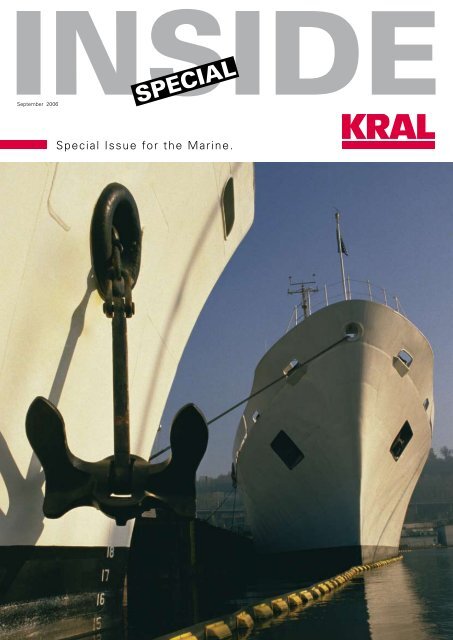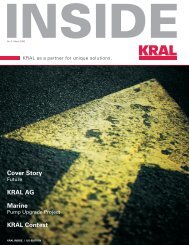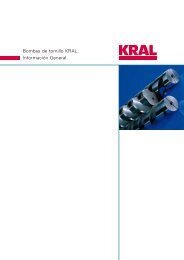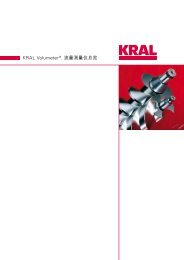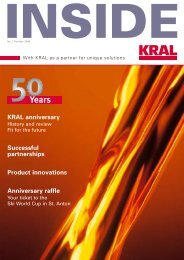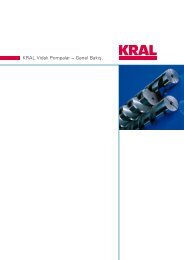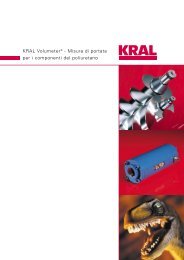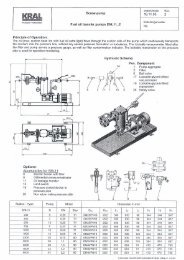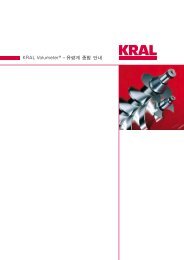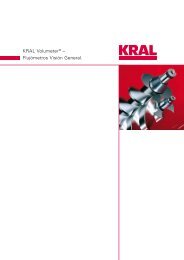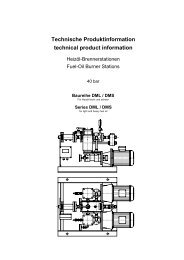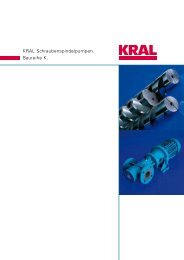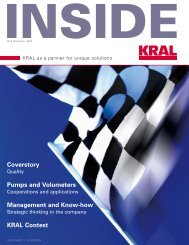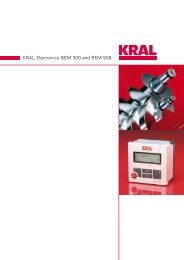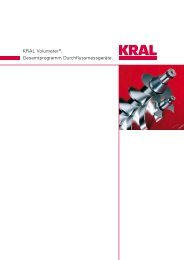INSIDE Special Marine - KRAL AG
You also want an ePaper? Increase the reach of your titles
YUMPU automatically turns print PDFs into web optimized ePapers that Google loves.
<strong>INSIDE</strong><br />
September 2006<br />
SPECIAL<br />
<strong>Special</strong> Issue for the <strong>Marine</strong>.
content<br />
<strong>KRAL</strong> as a partner for unique solutions<br />
SUCCESS DEMANDS CONTINUITY 03<br />
<strong>KRAL</strong> <strong>AG</strong> FOR MARINE APPLICATIONS 04<br />
THE OIL PRICE STORY 06<br />
<strong>KRAL</strong> PUMPS IN PRACTICAL MARINE APPLICATIONS 10<br />
PUMP UPGRADE FOR THE MARINE 12<br />
OUR PartnerS in THE marine<br />
PG MARINE GROUP 14<br />
Real Partnership Brings Global Customer Benefit.<br />
ROLLS-ROYCE 16<br />
A World Leader in <strong>Marine</strong> Solutions.<br />
E.R. SCHIFFAHRT 18<br />
Upgrading to <strong>KRAL</strong> Pumps With Magnetic Coupling.<br />
WESTFALIA SEPARATOR 20<br />
Hot Stuff.<br />
KUPKE + WOLF 22<br />
A Long Service Life Despite Cat Fines.<br />
MTU FRIEDRICHSHAFEN 24<br />
Fuel Consumption Measurement in Harsh Operating Conditions.<br />
CATERPILLAR 26<br />
World Class Diesel Engines.<br />
AALBORG INDUSTRIES 28<br />
World Leading Brand in <strong>Marine</strong> Boilers.<br />
JAN LOKKER & ZONEN 30<br />
Higher Profits Despite the Constant Increase in Fuel Prices.<br />
MOTOR YACHT „LARA“ 32<br />
Efficient Performance With the <strong>KRAL</strong> Consumption Measurement System.<br />
<br />
special
editorial<br />
Success demands continuity<br />
and concentration.<br />
Dear readers<br />
Stiff competition forces you to<br />
be fast and flexible as well as<br />
innovative and reliable in your<br />
dealings with your customers.<br />
You also expect these qualities<br />
from your shipbuilding partners<br />
and system providers.<br />
We at <strong>KRAL</strong> not only take these<br />
expectations very seriously, we<br />
have also adjusted our thinking<br />
and our actions to take them<br />
into account. As it is proven by<br />
the steadily increasing number<br />
of ship owners, shipyards and<br />
manufacturers of booster modules,<br />
diesel engines, transmissions<br />
and winches who believe<br />
in us.<br />
<strong>KRAL</strong> has proven that with<br />
innovative solutions, it is possible<br />
to have greater on-board<br />
safety and still reduce operating<br />
costs. With our first <strong>KRAL</strong><br />
<strong>INSIDE</strong> SPECIAL, <strong>Special</strong> Issue<br />
for the <strong>Marine</strong>, we want to present<br />
various solutions that have<br />
proved to be highly beneficial.<br />
Also included are reports from<br />
<strong>KRAL</strong> customers, which document<br />
the powerful presence of<br />
<strong>KRAL</strong> in marine engineering.<br />
The innovative solutions are<br />
the result of development with<br />
a practical emphasis. Our customers’<br />
requirements are not<br />
simply taken into account; they<br />
form the basis for tailor-made<br />
development results. You will<br />
benefit from our know-how<br />
both when building new ships<br />
and when modernizing existing<br />
ones.<br />
Fritz Huber<br />
CEO<br />
special
Introduction<br />
<strong>KRAL</strong> <strong>AG</strong> for marine applications.<br />
There is something romantic about life at sea which people still find fascinating. But in complete<br />
contrast, the commercial maritime business is subject to uncompromising demands. These<br />
include making journey times as short as possible and the increased costs of fuel, maintenance,<br />
service and personnel. So in shipbuilding, it is correspondingly important to have reliable<br />
partners who take these problems into account and provide solutions and services to give you a<br />
crucial edge.<br />
Our marine customers are internationally<br />
active organizations<br />
and groups, which need<br />
capable and efficient partners.<br />
There is currently a boom in<br />
modern navigation and shipbuilding,<br />
which means that we are<br />
facing some demanding tasks.<br />
Shipyards, ship owners, module<br />
and winch makers, as well<br />
as the manufacturers of diesel<br />
engines and marine boilers dominate<br />
activities at <strong>KRAL</strong> with<br />
60% of the business volume.<br />
It is not our aim to make business<br />
out of replacement parts.<br />
We want satisfied customers<br />
and are looking to the future.<br />
Many ships are modernized<br />
with our know-how. Many ship<br />
owners have also chosen <strong>KRAL</strong><br />
for their new ships. The pump<br />
upgrade project (page 12) and<br />
retrofitting with modern fuel<br />
consumption measurement systems<br />
are two of the successful<br />
examples. The manufacture<br />
of pumps and flowmeters for<br />
marine applications makes our<br />
company unique, and a consi-<br />
stently pursued growth strategy<br />
raises our profile and makes<br />
us better-known.<br />
Scope of supply for marine<br />
applications.<br />
<strong>KRAL</strong> supplies fuel pumps, hydraulic<br />
pumps and lubricating oil<br />
pumps for marine applications,<br />
as well as complete measurement<br />
systems for diesel engine<br />
fuel consumption.<br />
With our highly specialized<br />
partner, the PG <strong>Marine</strong> Group,<br />
we supply the smaller offshore<br />
supply ships, coastal tankers<br />
and drillships. E.R. Schiffahrt<br />
is one of our typical customers<br />
who equip their container ships,<br />
even up to the Post-Panamax<br />
size, with magnetically coupled<br />
<strong>KRAL</strong> pumps. Rolls-Royce gets<br />
the pumps for its anchor and<br />
deck winches from <strong>KRAL</strong>. In<br />
Germany, we are the market<br />
leader for supplying circulation<br />
and booster pumps to leading<br />
booster module manufacturers<br />
such as Kupke+Wolf and Westfalia.<br />
Strategy.<br />
If you want to be successful,<br />
you need a strategy. The stringent<br />
demands of marine applications<br />
require knowledge to<br />
be focussed and continuously<br />
extended. This is why we develop<br />
and produce our high-quality<br />
products at our company<br />
headquarters in Lustenau - Austria.<br />
We keep ourselves and our<br />
partners fit to face future challenges<br />
in ongoing internal and<br />
external training sessions.<br />
We provide an attractive standard<br />
program of products for<br />
marine applications.<br />
Our product designs are optimized<br />
with regard to cost,<br />
have a long service life and a<br />
high power density. We use<br />
high-quality norm materials and<br />
standardized components.<br />
We personally demand perfect<br />
quality from our solutions and<br />
services, which makes <strong>KRAL</strong><br />
your ideal partner for marine<br />
applications. We are on the list<br />
of suppliers for leading ship<br />
owners and shipyards, which is<br />
why we are often the original<br />
fitters.<br />
We help reduce costs for marine<br />
applications.<br />
Our hermetically sealed, magnetically<br />
coupled booster module<br />
pumps vastly reduce life<br />
cycle costs compared to the<br />
conventional, mechanically<br />
sealed pumps that were formerly<br />
used. Our fuel consumption<br />
measurement system can save<br />
so much fuel within short time<br />
that the system pays for itself in<br />
less than a year. The cost pressure<br />
caused by rising fuel prices<br />
calls for solutions that reduce<br />
<br />
special
consumption, thus minimizing<br />
the effect of the dramatic rise in<br />
the price of oil. Fuel consumption<br />
can be recorded with the utmost<br />
accuracy, thanks to <strong>KRAL</strong>’s<br />
twenty years of experience as<br />
a flow measurement specialist.<br />
Measurement results need to<br />
be precise as they determine<br />
the action to be taken to save<br />
expensive fuel.<br />
We target our innovations<br />
to the areas where they are<br />
needed.<br />
We have an eye for innovation,<br />
and at our test- and calibration<br />
rigs, we also run basic research.<br />
However, the input for the developments<br />
mostly comes<br />
from intensive investigations<br />
run jointly with our customers.<br />
We maintain a lively exchange<br />
of ideas with ship owners, shipyards,<br />
system suppliers, classification<br />
societies and universities,<br />
to meet the continuously<br />
increasing demands and needs<br />
of our customers.<br />
We do not think of ourselves as<br />
service engineers, who repair<br />
their products. We are installation<br />
analysts, taking a holistic<br />
approach to our customers’<br />
installations to cover both operating<br />
and environmental conditions.<br />
This enables us to make<br />
improvements exactly where<br />
our customers have previously<br />
had to accept restrictions. Our<br />
tailor-made solutions are the<br />
outcome of this collaboration.<br />
It is often the small improvements<br />
that were difficult to<br />
analyze which now ensure that<br />
operation is far more reliable.<br />
Our customers honor our innovative<br />
strength. They appreciate<br />
our help and keep us informed<br />
about future projects. In this<br />
way, we are often the original<br />
fitter.<br />
We are a reliable partner for<br />
our customers.<br />
<strong>KRAL</strong> <strong>AG</strong> has been working in<br />
the pump business for almost<br />
sixty years. The company will<br />
also remain in private ownership<br />
in the future, in the third<br />
generation. The positive attributes<br />
of an owner-managed<br />
company are strong identification<br />
with its products, its services<br />
and its values. This is how<br />
we keep our independence.<br />
This continuity creates security<br />
and belief. These are the advantages<br />
for our customers and for<br />
our workforce. Our response to<br />
customer requests is fast and<br />
unbureaucratic.<br />
We keep in close contact with<br />
our customers in the global<br />
market.<br />
As the business segments in<br />
which we are active rate highly<br />
on the international stage, a<br />
global presence is required.<br />
Our group headquarters is in<br />
Lustenau - Austria. In the USA<br />
we have our <strong>KRAL</strong> - USA subsidiary<br />
in Matthews, NC., and<br />
sales office in the Chicago<br />
area. Germany has three sales<br />
offices, and we also have 47<br />
partners representing us worldwide.<br />
This is how we make sure<br />
that advice, service and development<br />
projects can be quickly<br />
implemented.<br />
Safety on board ship is important<br />
to us.<br />
Maximum safety is a highly significant<br />
issue at sea. This must<br />
be viewed from the economic<br />
viewpoint, as well as with regard<br />
to the safety of the people<br />
on board ship. For <strong>KRAL</strong>, the<br />
particular challenge here is to<br />
maximize safety on board ship<br />
with needs-based solutions,<br />
such as a magnetically coupled<br />
pump. Leading <strong>KRAL</strong> technology<br />
ensures greater on-board<br />
safety and the reduction of the<br />
fire risk is in keeping with the<br />
IMO’s SOLAS (Safety Of Life At<br />
Sea) Convention.<br />
Fritz Huber<br />
CEO<br />
SPECIAL
MARket<br />
From two to more than 70 dollars –<br />
the oil price story.<br />
The age of low-cost energy is definitely over.<br />
For a long time it was not even possible to imagine the current oil price level. With fuel consumption<br />
measurement, <strong>KRAL</strong> gives customers the opportunity to save fuel.<br />
Everything was stable in the<br />
world of the oil market until<br />
the start of the seventies. Fuel<br />
was readily available and cheap.<br />
Then suddenly, OPEC, the Organization<br />
of Petroleum Exporting<br />
Countries, tightened the<br />
reins. In October 1973, OPEC<br />
cut production and started nationalizing<br />
the oil infrastructure.<br />
This was triggered by the conflict<br />
between Israel and the<br />
Arab countries during the fourth<br />
Middle East war. The first great<br />
oil crisis in history had arrived.<br />
The price of oil quadrupled. The<br />
oil price stayed at this far higher<br />
level until the end of the seventies.<br />
From then on, it was one<br />
thing after another. The Shah<br />
was toppled in Iran, and western<br />
oil companies were forced<br />
out of the country.<br />
40-dollar mark broken for the<br />
first time.<br />
In the early eighties, the oil price<br />
was already 40 dollars a barrel. In<br />
subsequent years, OPEC again<br />
increased its production quotas.<br />
There was now more North Sea<br />
oil on the market. Europeans<br />
had responded to the first oil crisis<br />
in the seventies by searching<br />
more industriously for their own<br />
sources of oil, to become more<br />
independent of OPEC oil. At the<br />
end of the eighties, oil was once<br />
again costing less than 20 dollars.<br />
At this time the Iraqi dictator,<br />
Saddam Hussein, converged<br />
on the neighboring country of<br />
Kuwait. America liberated the<br />
tiny Gulf State in its “Operation<br />
Desert Storm”. Oil prices,<br />
which had greatly increased during<br />
this crisis, fell dramatically.<br />
The trend in oil prices was unspectacular<br />
until 1997, when<br />
OPEC increased production quotas<br />
again. This increase in supply<br />
however encountered rapidly<br />
falling demand, owing to the<br />
economic crisis in Asia. Also,<br />
due to the unusually warm win-<br />
<br />
special
MARKet<br />
ter, stocks had grown considerably.<br />
As a result, the oil price fell<br />
to ten dollars.<br />
Historic low at the end of the<br />
nineties.<br />
Optimists were already envisioning<br />
oil prices of a mere 5<br />
dollars. OPEC‘s deft response<br />
was to reduce production quotas.<br />
To the amazement of many<br />
experts, the federation remained<br />
consistent and kept to the given<br />
quotas. Within two years,<br />
the oil price had tripled, until US<br />
President Bill Clinton released<br />
oil onto the market from the<br />
country‘s Strategic Petroleum<br />
Reserve. The recession in the<br />
USA went one step further. The<br />
price of black gold fell to less<br />
than 25 dollars. The price slump<br />
was also intensified by the terrorist<br />
attacks of September 11 in<br />
New York. Many market observers<br />
were envisaging a setback<br />
in economic activity and in the<br />
demand for oil. It was then that<br />
OPEC got its grip back on the<br />
oil market with reduced production.<br />
By the time of the Gulf war<br />
at the start of 2003, which led<br />
to the downfall of Saddam Hussein,<br />
the oil price had risen to<br />
almost 40 dollars. Fortunately,<br />
official military action only lasted<br />
a few weeks, and the infrastructure<br />
was not severely affected.<br />
The price of oil kept on going<br />
down.<br />
Boom in Asia.<br />
However, the fall in prices did<br />
not last long, as there was no<br />
stopping the economic boom in<br />
Asia. The demand for oil in 2004<br />
was rising faster than it had in<br />
the past 20 years. Several times<br />
the IEA, the International Energy<br />
Agency, had to adjust its oil demand<br />
forecasts upward. At the<br />
end of May, the tense supply<br />
situation was made more acute<br />
by the threat to Saudi oil installations<br />
from Islamic terrorists. Although<br />
OPEC wanted to expand<br />
production, fear of terrorism<br />
drove the price in New York to<br />
over 42 dollars. In August 2004,<br />
the oil price kept reaching new<br />
record levels, the last of which<br />
was virtually 49 US dollars. The<br />
50 dollar mark battle began. Various<br />
events, such as the threat<br />
of insolvency hanging over the<br />
Russian Yukos oil group, made<br />
the market ever more volatile.<br />
US-$ / Barrel Annual average.<br />
80<br />
75<br />
70<br />
65<br />
60<br />
55<br />
50<br />
45<br />
40<br />
35<br />
30<br />
25<br />
20<br />
15<br />
10<br />
5<br />
0<br />
1960 1965 1970 1975 1980 1985 1990 1995 2000 2005<br />
SPECIAL
MARKet<br />
No end in sight.<br />
On 28 September 2004, a barrel<br />
of light US oil cost more than<br />
50 dollars for the first time. Hurricane<br />
“Ivan” had had a highly<br />
adverse effect on oil production<br />
in the Gulf of Mexico. As a result,<br />
stocks in the USA declined<br />
sharply. On October 12, the International<br />
Energy Agency again<br />
raised its demand forecast. The<br />
price for US oil rose to over 54<br />
dollars. February 2005: after a<br />
phase of relative peace, the 50<br />
dollar mark was seen again. The<br />
relationship between high demand<br />
and tightly calculated supply<br />
became even more tense. Experts<br />
were further unsettled by<br />
the smoldering conflict over the<br />
Iranian nuclear program. In June<br />
2005, the oil price cleared the<br />
60 dollar mark for the first time.<br />
Worldwide production could<br />
hardly be increased any more.<br />
At the same time, despite the<br />
high prices, demand just kept on<br />
increasing. At the end of August<br />
2005, fear of hurricane Katrina in<br />
the Gulf of Mexico heaved the oil<br />
price in New York to over 70 dollars<br />
for the first time. Following<br />
the adverse effect on oil production<br />
caused by the hurricanes,<br />
many countries released some<br />
of their strategic petroleum reserves.<br />
By the end of 2005, the<br />
oil price had again clearly lost<br />
ground and fell below 60 dollars.<br />
Since the start of the New Year<br />
in 2006, the oil price has again<br />
continued to rise and recorded<br />
its record high in August at 73<br />
dollars per barrel. Responsible<br />
first af all for the steady price<br />
increase is the first for oil of the<br />
growing global economy, especially<br />
the emerging markets of<br />
India and China. Oil producers<br />
can hardly keep up with the rise<br />
in demand, their oil production<br />
facilities are running flat out.<br />
Secondly and currently keeping<br />
the mood tense on the market<br />
over recent months, is the conflict<br />
in the Middle East. Should<br />
the Middle East conflict escalate<br />
and Iran cease to be an oil supplier,<br />
it is perfectly conceivable<br />
that the price could rise to 100<br />
dollars. Whatever happens, the<br />
global demand for oil will remain<br />
heavy throughout 2006 and the<br />
trend of the last 30 years suggests<br />
that no price reduction is<br />
to be expected in the future.<br />
The response to the rise in<br />
oil prices is to save.<br />
The logical consequence of constantly<br />
rising oil and fuel prices<br />
is to find ways to conserve. At<br />
<strong>KRAL</strong> we have noticed that the<br />
high cost of energy is causing<br />
people to be more conservative<br />
in it’s use. Our customers who<br />
run internal-combustion engines<br />
now have the reduction of fuel<br />
consumption as their goal.<br />
Vast potential savings can easily<br />
be made by cost-conscious<br />
operation of diesel engines and<br />
turbine systems. In order for this<br />
to happen, the operator must be<br />
given the option of a reliable tool.<br />
Section through a <strong>KRAL</strong> Volumeter.<br />
A consumption measurement system<br />
includes two <strong>KRAL</strong> Volumeter.<br />
<strong>KRAL</strong> BEM 500 electronic system for measuring fuel consumption.<br />
<br />
special
Photo: Terje S. Knuden/Hydro.<br />
<strong>KRAL</strong> offers a fuel consumption<br />
measurement system for diesel<br />
engines and turbines operating<br />
on liquid fuel. The ideas for economical<br />
operation often come<br />
from our customers. They know<br />
their systems inside out. They<br />
know where they can make improvements.<br />
Fuel consumption measurement<br />
variations.<br />
The Lokker fishing business in<br />
this issue of <strong>KRAL</strong> <strong>INSIDE</strong> is<br />
an impressive example of how<br />
fuel can be saved. Lokker saves<br />
a substantial amount of money<br />
simply by relieving the load on<br />
the diesel engine. This technological<br />
option can be transferred<br />
from a fishing boat to other<br />
ships.<br />
Railway companies also run<br />
energy saving programs. With<br />
electric locomotives, it is easy<br />
to monitor energy consumption<br />
with a current meter. With diesel<br />
locomotives, it is a more demanding<br />
task. The layout of the<br />
fuel system makes it necessary<br />
to measure the diesel fuel both<br />
in the forward and return flow of<br />
the injection pump. The difference<br />
between the forward flow<br />
and the return flow is the volume<br />
of fuel that the engine has used.<br />
Modern diesel engine train units<br />
have an underflow drive. There<br />
is an extremely limited amount<br />
of space available to install additional<br />
measurement systems.<br />
For this application, <strong>KRAL</strong> provides<br />
a compact measurement<br />
module that contains two <strong>KRAL</strong><br />
Volumeter, together with the<br />
sensors.<br />
It is a different situation for<br />
power stations with diesel engines.<br />
About 80% of the operating<br />
costs for installations of this<br />
type are the fuel costs. The economic<br />
efficiency of these power<br />
stations is determined largely by<br />
fuel consumption. This is why<br />
power station operators have<br />
the specific fuel consumption<br />
guaranteed. During the warranty<br />
period, this guaranteed performance<br />
can be monitored using<br />
<strong>KRAL</strong> fuel consumption measurement<br />
systems.<br />
Engine manufacturers measure<br />
fuel consumption on production<br />
test stands or in the continuous<br />
operation of the installed<br />
engine. On page 26, Caterpillar<br />
describes the need for <strong>KRAL</strong><br />
consumption measurement, as<br />
when contracts are concluded,<br />
the consumption specification is<br />
a component part of the contract.<br />
MTU Friedrichshafen GmbH<br />
demonstrates its customer-orientation<br />
on page 24. With the<br />
<strong>KRAL</strong> fuel consumption measurement<br />
system installed, MTU<br />
offers its customers a measuring<br />
accuracy that cannot be achieved<br />
simply by measuring the level<br />
in the tank. This enables MTU<br />
customers to run their engines<br />
efficiently.<br />
Thomas Flauger<br />
Product Manager<br />
SPECIAL
TECH NEWS<br />
<strong>KRAL</strong> pumps in practical marine<br />
applications.<br />
<strong>KRAL</strong> screw pumps with magnetic coupling have crucial advantages for use in fuel supply<br />
systems on board ship. These include lower life cycle costs and significantly higher operational<br />
safety.<br />
With very few exceptions, ships<br />
are run on mineral oil fuels. Socalled<br />
distillates or residual oils<br />
are used, in accordance with<br />
local regulations and availability.<br />
The most economically<br />
significant fuels are diesel and<br />
heavy oil.<br />
Heavy oils cannot be supplied<br />
to the engines straight away.<br />
They must be conditioned in<br />
the ship’s own separators and<br />
fuel modules. These filter out<br />
the solids, separate the water<br />
and adjust the viscosity of the<br />
fuel by heating. For each megawatt<br />
of power, about 5 liters<br />
of fuel flows to the propulsion<br />
engine every minute.<br />
Safe delivery process.<br />
Fuels must be delivered from<br />
the feeding tanks to the service<br />
tanks, forwarded to the separators<br />
and fuel modules and<br />
from there to the fuel injection<br />
pumps of the engines. <strong>KRAL</strong><br />
screw pumps are ideal for this<br />
purpose. Because of their high<br />
power density and associated<br />
compact design, screw pumps<br />
offer economic advantages and<br />
are well established in this application.<br />
They are self-priming,<br />
positive displacement pumps,<br />
which can deliver fuel safely<br />
from deeper-lying tanks. Due to<br />
the special principle of positive<br />
displacement with fully continuous<br />
axial displacement of<br />
the liquid, the fuel is delivered<br />
particularly gently and is not<br />
emulsified. This is important,<br />
to assure that any condensation<br />
Tank<br />
K-series pump<br />
C-series pump<br />
Steam generator<br />
DS-series<br />
double<br />
station<br />
Engine<br />
Fuel injection<br />
pump<br />
K-series pump<br />
Mixing tank<br />
K-series pump<br />
Service<br />
tank<br />
Separator<br />
K-series pump<br />
Tank<br />
Boostermodule<br />
Possible uses for <strong>KRAL</strong> screw pumps on-board ships.<br />
10 special
TECH NEWS<br />
<strong>KRAL</strong> screw pumps with magnetic coupling.<br />
water contained in the fuel can<br />
be removed in the separators<br />
by centrifuging. The “rigid” characteristic<br />
curves of the pumps,<br />
that is the minimal effect that<br />
changes in viscosity or pressure<br />
have on the delivery rate,<br />
are a further advantage, when<br />
changes in temperature caused<br />
by the climate or the operating<br />
conditions bring about changes<br />
in the viscosity of the fuel.<br />
Improving the availability of<br />
the ship’s propulsion systems.<br />
The properties of the fuels being<br />
used make great demands on<br />
the pumps. Heavy oil, for instance,<br />
is extremely viscous<br />
at ambient temperature, and<br />
despite extensive filtering, abrasive<br />
foreign particles cannot<br />
be totally suppressed.<br />
The benefits of magnetically<br />
coupled pumps.<br />
When a pump fails, the seal is<br />
often the cause. Conventional<br />
shaft seals such as a rotary<br />
shaft lip seal or a mechanical<br />
seal have the disadvantage<br />
that they work with frictional<br />
elements in the sealing gap<br />
and always require functional<br />
leakage.<br />
For some considerable time,<br />
hermetically sealed magnetic<br />
coupling pumps have been<br />
used in the chemical industry<br />
for liquids that must not be<br />
allowed to enter the environment.<br />
Magnetic couplings only<br />
have static sealing elements.<br />
The actual sealing element is<br />
the fixed, built-in can made of<br />
stainless steel. Torque is transmitted<br />
from the engine to the<br />
pump shaft without contact.<br />
The magnetic couplings are<br />
wear-resistant, which increases<br />
the operational safety of the<br />
pump considerably. A further<br />
benefit is that because magnetically<br />
coupled pumps are hermetically<br />
sealed, the pumped<br />
medium does not escape into<br />
the atmosphere and the fuel<br />
module stays clean.<br />
Higher level of safety at lower<br />
costs.<br />
The life cycle costs of a screw<br />
pump with magnetic coupling<br />
are more reasonable than those<br />
of a screw pump with conventional<br />
seal. The magnetically<br />
coupled pump already pays off<br />
within a period of 3 years. In<br />
case of ship failure, the extra<br />
cost of a magnetic coupling is in<br />
no proportion to the daily charter<br />
rate of up to USD 30.000 for<br />
a large container vessel.<br />
Thomas Flauger<br />
Product Manager<br />
The operational safety of the<br />
fuel pumps is crucial for the<br />
availability of the ship’s propulsion<br />
system. The costs associated<br />
with unit failure on board<br />
ship are high.<br />
<strong>KRAL</strong> screw pumps with magnetic coupling in a fuel module.<br />
SPECIAL<br />
11
TECH NEWS<br />
Pump Upgrade for the <strong>Marine</strong>.<br />
No more problems with mechanical seals!<br />
As a trial and return project, <strong>KRAL</strong> has been offering hermetically sealed pumps for boostermodules<br />
to ship owners and operators. These fuel pumps can reduce life cycle costs and increase<br />
engine room safety. At present, every ship owner who has made the test has chosen<br />
to keep the pumps.<br />
Fig. 1: Typical booster module screw pump<br />
with mechanical seal.<br />
Fig. 2: Accumulation of leakage residue in a<br />
pump with mechanical seal.<br />
Defects of screw pumps in marine<br />
booster-modules are some<br />
of the most frequent incidents<br />
affecting life cycle costs and<br />
ship’s availability. Pump designs<br />
with mechanical seals<br />
will always incur a distinct risk<br />
of breakdown. A decisive step<br />
forward in solving this problem is<br />
to avoid the shaft seal. The alternative<br />
technology are hermetically<br />
sealed pumps with magnetic<br />
coupling. Magnetic couplings<br />
overcome the limitations otherwise<br />
common with mechanical<br />
seals in screw pumps. At the<br />
end of the day, the long list of<br />
advantages of using <strong>KRAL</strong> hermetically<br />
sealed screw pumps<br />
will keep providing the bonuses<br />
of safety as well as low operating<br />
and maintenance costs.<br />
Mechanical seals require<br />
lubrication of the seal faces.<br />
Screw pumps are typically driven<br />
by electric motors. The connection<br />
between the electric<br />
motor and the set of spindles almost<br />
always incorporates a mechanical<br />
seal. Mechanical seals<br />
are widely utilized and have advanced<br />
in technology. Regardless<br />
of their proper usage, mechanical<br />
seals have wearing<br />
parts. To lubricate the seal faces,<br />
manufacturers of mechanical<br />
seals specify a leakage flow.<br />
It is important to note, that a<br />
low amount of leakage – some<br />
ccm/h – is normal and part of a<br />
well engineered design! Fig. 1<br />
shows a screw pump with mechanical<br />
seal. Low volatile liquids<br />
which tend to form solid<br />
residues in contact with ambient<br />
oxygen may accumulate in<br />
the leakage drain. The quality of<br />
the mechanical seal, especially<br />
the material of the sealing faces<br />
and the O-rings are designed according<br />
to the application. Fig.<br />
2 shows a sample where the<br />
motor bracket was nearly completely<br />
filled with coke and carbon<br />
residues after approx. two<br />
years of operation. This accumulation<br />
was caused by the<br />
normal leakage which lubricates<br />
the mechanical seal.<br />
Magnetic coupled pumps are<br />
the solution to mechanical<br />
seal problems.<br />
<strong>KRAL</strong> screw pumps with mechanical<br />
seal have been improved<br />
for HFO operation in engine<br />
rooms. However, to be on<br />
the very safe side, <strong>KRAL</strong> has developed<br />
the magnetic coupled<br />
pump as an alternative solution<br />
which completely avoids a mechanical<br />
seal. In screw pumps<br />
with magnetic couplings, the<br />
connection between the electric<br />
motor and the pump shaft is not<br />
a fixed mechanical attachment.<br />
Permanent magnets are fastened<br />
to pump and motor shaft<br />
so that they face one another.<br />
The magnets on the motor shaft<br />
transfer the torque to the magnets<br />
on the pump shaft thereby<br />
rotating the pump spindles. Serving<br />
to seal the pump against the<br />
atmosphere, there is a hermeti-<br />
Cornelius Maersk in the Malacca Strait.<br />
cally tight sealing element – the<br />
containment can – located in the<br />
gap between the opposing magnets.<br />
In Fig. 3 the magnets are<br />
marked red. Once the piping is<br />
connected, the pump is safely<br />
protected inside a perfectly tight<br />
casing. In Fig. 4 you can see the<br />
hermetically sealed pump in the<br />
front, and in the background, the<br />
<strong>KRAL</strong> pump with attached electric<br />
motor.<br />
Fig. 4: Front: Hermetically sealed pump<br />
casing with can. Back: <strong>KRAL</strong> screw pump<br />
with motor.<br />
12 special
lindtext<br />
Fig. 3: <strong>KRAL</strong> screw pump with magnetic coupling. The magnets are marked in red.<br />
Reduced life cycle- and<br />
attractive investment costs.<br />
Spare parts and maintenance<br />
costs of mechanical seals increase<br />
life cycle costs. The use<br />
of high quality mechanical seals<br />
in <strong>KRAL</strong> screw pumps is the<br />
standard. Even when properly<br />
applied, mechanical seals are<br />
subject to wear. Spare parts and<br />
maintenance costs arise.<br />
<strong>KRAL</strong> magnetic couplings are<br />
maintenance free. The cost premium<br />
of a pump with a magnetic<br />
coupling will be typically amortized<br />
after only three years of<br />
operation.<br />
The attractive priced investment<br />
is a result of the optimized design<br />
of our new generation.<br />
<strong>KRAL</strong> has been successfully<br />
manufacturing magnetic coupled<br />
pumps for many years. For<br />
high torque transmission our<br />
couplings utilize high strength<br />
Sm 2<br />
Co 17<br />
permanent magnets.<br />
The maximum energy density of<br />
approx. 400 kJ/m 3 is five times<br />
greater than standard Al Ni Co<br />
magnets.<br />
The magnetic coupling is very<br />
compact. The containment can<br />
is the sealing element of the<br />
pump. Utilizing such strong<br />
magnets, the size of the containment<br />
can is minimized making a<br />
substantial contribution to cost<br />
reduction as well as to reduce<br />
friction and eddy current losses.<br />
The competence of <strong>KRAL</strong> in<br />
magnetic technology helps lower<br />
the costs for ship owners.<br />
The <strong>KRAL</strong> pump upgrade<br />
project.<br />
To make the decision easy,<br />
<strong>KRAL</strong> offers not only the magnetic<br />
coupled pump but also<br />
an upgrade project. In co-operation<br />
with innovative ship owners<br />
we select a ship of the sailing<br />
fleet which needs some<br />
improvements. For this vessel<br />
we offer two booster-pumps, if<br />
requested free of charge, for a<br />
certain trial and return period. If<br />
necessary, <strong>KRAL</strong> service engineers<br />
can help for replacement<br />
and start-up. After the trial period<br />
we are confident the ship<br />
owner will experience a more<br />
reliable operation, a clean installation<br />
area, and a generally<br />
increased safety on board with<br />
no fuel leakage.<br />
In 2003 <strong>KRAL</strong> contacted A.P.<br />
Moeller – Maersk in Denmark<br />
about the option to utilize magnetic<br />
coupled pumps for heavy<br />
fuel oil booster units in large<br />
marine installations. To reduce<br />
the life cycle cost, A.P. Moeller<br />
replaced some existing mechanical<br />
seal circulating pumps<br />
with <strong>KRAL</strong> magnetic coupled<br />
pumps. To be sure that the proposed<br />
technology of magnetic<br />
coupled pumps could improve<br />
their situation, A.P. Moeller requested<br />
a three month trial.<br />
<strong>KRAL</strong> dispatched their service<br />
engineer to the site and<br />
installed the new pump with<br />
magnetic coupling on the first<br />
Maersk vessel. After the trial<br />
period it was clear that this<br />
technology offered the benefits<br />
A.P. Moeller anticipated.<br />
Thomas Flauger<br />
Product Manager<br />
SPECIAL<br />
13
PARTNER<br />
PG <strong>Marine</strong> Group.<br />
Real partnership brings global customer benefit.<br />
The PG <strong>Marine</strong> Group and <strong>KRAL</strong> <strong>AG</strong> share a vision: We want to supply<br />
our customers with tailor-made solutions to help them meet the<br />
constantly changing demands of the marine market.<br />
Roy Norum, President and CEO of the PG <strong>Marine</strong> Group in Norway<br />
(formerly CEO of the COLFAX Pump Group – International Navigation Division).<br />
The PG <strong>Marine</strong> Group is a supplier<br />
of individual pumps and complete<br />
systems for marine applications.<br />
This includes complete engine<br />
room packages, cargo offload<br />
pumps as well as systems for<br />
tankers and offshore supply vessels<br />
for drilling platforms.<br />
To enable us to quickly and reliably<br />
resolve demanding and<br />
complex tasks for our customers<br />
anywhere in the world,<br />
we maintain partnerships with<br />
leading companies with noted<br />
global brands. What our partners<br />
all have in common is that they<br />
are recognized and competent<br />
specialists in their own particular<br />
areas of operation.<br />
PG and <strong>KRAL</strong> enjoy a close partnership<br />
which has enabled them,<br />
together, to become genuine global<br />
players. Our success is based<br />
on the common ground shared<br />
by our corporate cultures, one<br />
essential element of which is<br />
innovation. Our reciprocal partnership<br />
enables us to meet the<br />
challenges we face every day and<br />
improve the services we provide<br />
for our customers.<br />
Partnership.<br />
The PG <strong>Marine</strong> Group concentrates<br />
its business development on<br />
a clearly defined niche market.<br />
Our company operates in the oil<br />
and gas industry in marine and<br />
process engineering. Since the<br />
founding of the company in 1982,<br />
PG’s core area has been the North<br />
Sea offshore market. We have<br />
developed unique technologies<br />
here over the years, which now<br />
enjoy global acceptance and application.<br />
PG is an international operation.<br />
In terms of business volume and<br />
technology, we are the market<br />
leaders in North and South America,<br />
Asia and Europe. Our success<br />
is based on accurate knowledge<br />
of the market, leading products,<br />
and cooperation with progressive<br />
manufacturers.<br />
Market.<br />
PG is an independent engineering<br />
and systems integration business<br />
with its own manufacturing division.<br />
So far this year, our company<br />
has supplied marine equipment<br />
of various kinds to about 100<br />
ships. We are the market leader<br />
for offshore supply vessels. We<br />
have a significant market share<br />
for pump and compressor systems<br />
in the oil industry.<br />
14 special
PARTNER<br />
Innovation.<br />
Together with <strong>KRAL</strong>, PG supplies<br />
pumps for the anchor winches of<br />
Rolls-Royce <strong>Marine</strong>. Determination,<br />
a clear message, good products<br />
and above all, the ability<br />
to recognize market trends and<br />
respond to them in the right way<br />
and for the benefit of the customer,<br />
secures us our pole position.<br />
At PG, we have many areas of<br />
application for <strong>KRAL</strong> products.<br />
Together, we are successful in<br />
areas from which our competitors<br />
have withdrawn.<br />
The advantage that <strong>KRAL</strong> has<br />
over other marine supplier competitors<br />
can be explained in just a<br />
few statements, which this time<br />
come from someone who was<br />
actually a main competitor actively<br />
looking to refute the following<br />
facts about <strong>KRAL</strong>:<br />
Flexibility and the will to address<br />
changes in direction at<br />
an early stage.<br />
Products that are designed with<br />
a particular requirement in<br />
mind and which are destined<br />
for a specific application, not<br />
technical installations that have<br />
been borrowed from elsewhere.<br />
Good price/performance ratio<br />
as a result of the facts stated<br />
above.<br />
A complete and steadily increasing<br />
range of high quality<br />
products.<br />
50 years of experience in making<br />
system solutions, which<br />
are superior to those of most<br />
of their competitors.<br />
Resolute in their determination to<br />
expand and develop on the world<br />
market, the PG <strong>Marine</strong> Group and<br />
<strong>KRAL</strong> will cooperate closely to<br />
accept the changes that occur in<br />
the marine and offshore business<br />
environment.<br />
Both <strong>KRAL</strong> and PG are investing<br />
in their infrastructure and their<br />
workforce, to make them fit<br />
the future. By developing new<br />
areas of operation, we are still<br />
on-course for growth. We have<br />
now been working together with<br />
<strong>KRAL</strong> for 25 years, and this long<br />
tradition of cooperation is set to<br />
continue. We are still in the same<br />
boat with our powerful partners,<br />
because we view this as the best<br />
recipe for future success.<br />
Roy Norum, CEO<br />
PG <strong>Marine</strong> Group<br />
SPECIAL<br />
15
PaRTNER<br />
Rolls-Royce.<br />
A World Leader in <strong>Marine</strong> Solutions.<br />
Rolls-Royce, the world’s leading provider of power systems and services for use on land, sea<br />
and air, operates in four global markets - civil aerospace, defence aerospace, marine and energy<br />
markets. It is investing in core technologies, capabilities and infrastructures that can be applied<br />
across these sectors to take a competitive range of products to market. These investments<br />
create high barriers to entry.<br />
derstand who we are and our<br />
business strategy. We seek to<br />
add value for our customers<br />
with aftermarket services that<br />
will enhance the performance<br />
and reliability of our products.<br />
This approach is fundamental to<br />
developing and sustaining collaborative<br />
long-term relationships<br />
Mooring winch.<br />
across all our markets.<br />
operators, 160 armed forces and<br />
Stena Vision.<br />
Rolls-Royce.<br />
A sounding brand.<br />
Rolls-Royce is renowned for<br />
its high-quality world-class products.<br />
Every day we put this<br />
reputation into practice. Wherever<br />
our customers are in the<br />
world, whenever they come into<br />
contact with one of our people,<br />
they expect and receive a high<br />
standard of service. We aim to<br />
be ‚trusted to deliver excellence‘<br />
in everything we do.<br />
A competitive portfolio of products<br />
and services.<br />
According to our strategy, Rolls-<br />
Royce addresses a global market.<br />
We are a leading powersystems<br />
company in civil and<br />
defence aerospace, marine and<br />
energy markets. We manufacture<br />
in 20 countries and serve<br />
customers in 150 countries.<br />
The success of the company’s<br />
products is demonstrated by<br />
its rapid and substantial gains in<br />
market share. Rolls-Royce has a<br />
broad customer base comprising<br />
600 airlines, 4.000 corporate<br />
and utility aircraft and helicopter<br />
more than 2.000 marine customers,<br />
including 70 navies. The<br />
company has energy customers<br />
in 120 countries. Rolls-Royce is<br />
a technology leader, employing<br />
around 36.000 people in offices,<br />
manufacturing and service facilities<br />
in 50 countries. We are<br />
involved in many of the major<br />
future projects in the markets<br />
we serve.<br />
Rolls-Royce. A world leader in<br />
the <strong>Marine</strong> solutions.<br />
The Rolls-Royce marine business<br />
is a global leader in marine propulsion,<br />
engineering and hydrodynamic<br />
expertise, with a broad<br />
Rolls-Royce has offices, manufacturing<br />
sites or service centres<br />
located in 50 countries around<br />
the world. The diversity of our<br />
people and culture is a key<br />
strength of our global brand.<br />
Our people are building longterm<br />
relationships, helping our<br />
customers and partners to un-<br />
Anchor handling winch plant.<br />
16 special
Stena Caribbean C-Max.<br />
product range and full systems<br />
integration capability.<br />
Rolls-Royce offers a product<br />
portfolio ranging from vessel<br />
design and gas turbine engines<br />
to water jets and deck handling<br />
equipment. The business is<br />
unique in its scope and capabilities,<br />
with the aim of supplying<br />
power, propulsion and motion<br />
control systems for high-value<br />
vessels. The Rolls-Royce marine<br />
business boasts:<br />
7.000 employees.<br />
2.000 customers.<br />
Main manufacturing in the UK,<br />
North America and Scandinavia.<br />
Equipment on over 20.000<br />
vessels.<br />
Sales and service in 34 countries.<br />
Our installed bases are:<br />
Offshore supply and support<br />
- over 800 vessels.<br />
Commercial shipping - over<br />
15.000 vessels.<br />
Warships - 2.200 ships.<br />
Submarines - over 50 boats.<br />
Rolls-Royce Brattvaag.<br />
The Brattvaag facility develops<br />
winch systems and deck machinery<br />
based on Rauma Brattvaag<br />
hydraulic technology for<br />
the merchant and offshore market.<br />
The site has approximately<br />
410 employees and was established<br />
in 1941 on the West<br />
Coast of Norway in Brattvaag,<br />
a small village outside the city<br />
of Ålesund. In October 1999 the<br />
site opened a new FMS-system,<br />
the biggest flexible production<br />
system in Europe, where production<br />
and warehouse administration<br />
is built on the principle<br />
of „on-piece float“ (in contrast<br />
to batch production) and Kanban<br />
control to regulate production.<br />
Cooperation with <strong>KRAL</strong>.<br />
According to our strategy “Invest<br />
technology“, we contacted the<br />
<strong>KRAL</strong> <strong>AG</strong> regarding pumps for<br />
winch plants. The simple target<br />
was to have one more supplier.<br />
We have been amazed that the<br />
discussion with <strong>KRAL</strong> came to a<br />
very innovative, constructive and<br />
co-operative level. Dr. Christoph<br />
Schneider, Technical Manager<br />
of <strong>KRAL</strong>, is a brilliant scientist<br />
with a strong focus on feasible<br />
practise. The technicians of both<br />
companies, <strong>KRAL</strong> and Rolls-Royce,<br />
not only analysed the pump<br />
but also the complete winch<br />
plant. A significant part of the<br />
new and reliable pump sealing<br />
technology was carried out by<br />
<strong>KRAL</strong>. Both companies invested<br />
in technology to generate added<br />
value for the system and to reduce<br />
life cycle costs.<br />
Charles Kvalvik<br />
Strategic Sourcing <strong>Special</strong>ist<br />
CoE Deck Machinery<br />
SPECIAL<br />
17
partner<br />
E.R. Schiffahrt GmbH & Cie.<br />
Upgrading to <strong>KRAL</strong> pumps with magnetic coupling.<br />
The Nordcapital group of companies is active in shipping, real estate and private equity. Since its<br />
foundation in 1992, it has realized an investment volume of around EUR 4,5 billion for its private<br />
and institutional investors. Around 34.000 investors with 46.000 shareholdings and a fund capital<br />
of EUR 1,8 billion are invested in Nordcapital funds. In the shipping funds sector, Nordcapital has<br />
so far set up 85 funds with a total of 94 vessels.<br />
E.R. Schiffahrt headquarters in Hamburg.<br />
The largest subsidiary company<br />
of the group is E.R. Schiffahrt,<br />
which began operations in 1998<br />
with the delivery of the first<br />
three container vessels. Thanks<br />
to Nordcapital‘s financial power,<br />
the shipping company grew<br />
rapidly to its present size. E.R.<br />
Schiffahrt is one of the largest<br />
charter owners of container vessels<br />
worldwide. It is responsible<br />
for project development and<br />
for the commercial and technical<br />
management of 78 container<br />
ships with a capacity of around<br />
350.000 TEU. Of these, 16 units<br />
(100.000 TEU) are under construction<br />
and will be in service<br />
by 2008. E.R. Schiffahrt arranges<br />
charters for the vessels, provides<br />
technical support, as well<br />
as selection and allocation of the<br />
crews, thereby keeping the factors<br />
that are crucial to the success<br />
of the shipping funds within<br />
the group.<br />
Container shipping is a<br />
growth market.<br />
Nowadays the world trade picture<br />
looks somewhat different to that<br />
of a few years ago. Globalization<br />
and the rise of China to become<br />
an internationally significant<br />
economic power require globally<br />
networked logistics systems,<br />
increasing the demand for efficient<br />
and powerful means of<br />
transport. Container shipping<br />
bears the brunt of this in the true<br />
sense of the word and is recording<br />
correspondingly high rates of<br />
growth.<br />
Nowadays, up to 98% of intercontinental<br />
goods traffic goes by doubled every seven to eight<br />
container traffic has on average<br />
sea. For more than 20 years, the years. In 2005, the growth rate<br />
segment that has seen the most was 9,9%.<br />
expansion here is container traffic.<br />
The reason for the tremendous<br />
growth of container shipboard<br />
safety.<br />
Quality assurance and onping<br />
lies firstly in the increasing A safety and quality management<br />
system certified by Ger-<br />
volume of world trade and secondly<br />
in the fact that more and manischer Lloyd in accordance<br />
more varied types of containers with ISO 9001:2000 and ISO<br />
are being transported. Increasing<br />
quantities and ever more with high quality, safety and en-<br />
14001:2004 ensures compliance<br />
efficient logistics concepts have vironmental standards. The safety<br />
and quality management is<br />
reduced transport costs so far<br />
that nowadays it is even viable adapted from statutory provisions<br />
to carry low-cost products and and internal guidelines. Training<br />
semi-finished goods.<br />
programs and regular drills, as<br />
well as monthly ship management<br />
meetings insure that these<br />
Between 1980 and 2004, container<br />
port transshipment increased<br />
virtually tenfold, to realized in daily working practice.<br />
standards are implemented and<br />
about 340 million TEU. So far, Germanischer Lloyd keeps watch<br />
Testing took place onboard a Panamax class vessel, the E.R. Kingston.<br />
18 special
The Post-Panamax class E.R. Canada was also upgraded.<br />
to ensure compliance with ISM,<br />
the International Safety Management<br />
code.<br />
The “pump upgrade” project.<br />
The container fleet at E.R.<br />
Schiffahrt is divided into four<br />
classes. Vessels with the highest<br />
stowing capacity (8.204 to<br />
5.762 TEU) belong to the Post-<br />
Panamax class, because, at over<br />
32,2 meters in width, they can<br />
no longer pass through the Panama<br />
Canal. Then there are the<br />
Panamax class (5.075 to 3.400<br />
TEU), i.e. vessels that can still<br />
just get through the Panama Canal,<br />
and the Sub-Panamax class<br />
(2.825 to 2.226 TEU). The smallest<br />
volumes are transported by<br />
the Feeder class (2.004 to 1.728<br />
TEU). These are vessels that<br />
feed the large units with cargo<br />
from the smaller ports.<br />
Each individual vessel needs intensive<br />
preventive maintenance.<br />
As E.R. Schiffahrt concentrates<br />
on optimizing quality and safety,<br />
in 2004 those responsible were<br />
looking for a permanent solution<br />
to the problem of regularly<br />
having to replace the mechanical<br />
seals in the booster module<br />
pumps. E.R Schiffahrt found a<br />
competent contact in <strong>KRAL</strong>.<br />
<strong>KRAL</strong> presented their new development,<br />
the K Series pumps<br />
with magnetic coupling. The negotiating<br />
parties agreed first of all<br />
to a test installation on the E.R.<br />
Kingston, which at 4.253 TEU is<br />
a vessel of the Panamax class.<br />
Four <strong>KRAL</strong> pumps with magnetic<br />
coupling were installed as<br />
the supply and booster pumps in<br />
April 2005. Testing was agreed<br />
for a period of six months and<br />
results were extremely positive.<br />
Completely satisfied with the<br />
technical solution, E.R. Schiffahrt<br />
also upgraded the pumps<br />
in the booster module on six of<br />
their Post-Panamax class vessels<br />
and on two other Panamax<br />
class ships.<br />
Convincing in action.<br />
<strong>KRAL</strong> pumps with magnetic<br />
coupling are reliable and tough,<br />
working qualities that are really<br />
appreciated by the engineers in<br />
the engine room.<br />
“As well as <strong>KRAL</strong>‘s excellent<br />
technical solution, we at E.R.<br />
Schiffahrt particularly appreciate<br />
their technical support and<br />
the communication with <strong>KRAL</strong>,”<br />
says Uwe Dardaillon, Senior Superintendent<br />
in the team of inspectors<br />
at E.R. Schiffahrt.<br />
Nordcapital<br />
Hamburg<br />
SPECIAL<br />
19
partner<br />
Hot stuff.<br />
Individual booster units for engine-specific conditioning of fuel up to<br />
150 °C in temperature.<br />
It is the customer who decides on success or failure, not the eye of the provider. It is easier to<br />
meet high customer expectations at all times with reliable partners and suppliers. In marine applications,<br />
safety is the order of the day.<br />
In 1893, Westfalia Separator<br />
began designing hand-driven<br />
centrifuges at its Olde facility<br />
in Germany. These have long<br />
since become automatic systems<br />
running “24 hours a day”.<br />
Westfalia Separator has since<br />
diversified and is now a globally<br />
operating organization. With its<br />
trend-setting innovations, Westfalia<br />
Separator is defining international<br />
standards for efficiency,<br />
performance and reliability in<br />
centrifugal separation technology.<br />
In its Mineraloil Systems division,<br />
Westfalia makes booster<br />
units for marine applications.<br />
<strong>KRAL</strong> has been supplying the<br />
pumps for these modules for<br />
five years.<br />
Building a new ship is a highly<br />
complex project. Thousands of<br />
individual items have to be taken<br />
into consideration during planning<br />
and installation. It makes life<br />
easier for shipyards and shipping<br />
companies if individual, associated<br />
units are combined to make<br />
a system. In addition, modern,<br />
modular systems significantly reduce<br />
engineering and installation<br />
costs for shipyards and shipping<br />
companies.<br />
Booster units for enginespecific<br />
fuel conditioning.<br />
A ship‘s engine will only run<br />
true with optimum fuel conditioning.<br />
With its Visco booster<br />
unit, Westfalia Separator Mineraloil<br />
Systems has developed<br />
a reliable system to ensure that<br />
this is precisely what happens.<br />
The classical heavy fuel oil supply<br />
module adjusts the viscosity,<br />
temperature and pressure<br />
downstream of the day tank exactly<br />
as required by the engine<br />
manufacturer for normal operation<br />
of their machines. By including<br />
this unit into its production<br />
range, Westfalia Separator<br />
is now able to provide heavy<br />
fuel oil treatment both upstream<br />
and downstream of the service<br />
tank. A further piece in the system<br />
technology jigsaw for the<br />
complete engine room.<br />
The newly developed Visco booster units for fuel conditioning meet individual requirements and expectations of the customers.<br />
User-friendly: integrated<br />
control cabinet.<br />
Booster units adjust the temperature<br />
and viscosity of the heavy<br />
fuel oil to precisely meet the<br />
needs of the particular engines<br />
used, and <strong>KRAL</strong> K Series booster<br />
pumps ensure that there is<br />
the required system pressure<br />
at the injection pumps. The integrated<br />
control cabinet is a key<br />
feature of Westfalia Separator<br />
modules. It houses all the necessary<br />
measuring and control<br />
units and so significantly reduces<br />
the installation effort. It’s modular<br />
design allows the booster<br />
unit to be connected on both<br />
sides, further increasing installation<br />
flexibility. Westfalia Separa-<br />
20 special
A ship’s engine will only run true with optimum fuel conditioning.<br />
tor has also made sure that all<br />
the machine components are<br />
readily accessible, a major advantage<br />
when working on-board<br />
ship. A convenient, user-friendly<br />
interface with a text display on<br />
the front of the control cabinet<br />
simplifies operation.<br />
No problem with sludge<br />
particles.<br />
A persistent issue on-board<br />
ship is the storage, disposal and<br />
cost problems involved with<br />
the sludge particles that occur<br />
when oils are conditioned. This<br />
is why the Visco booster units<br />
include automatic, compressed<br />
air driven backflush filters which<br />
produce a sludge content many<br />
times lower than that of conventional<br />
filter systems which are<br />
flushed by the system‘s own<br />
media. If necessary, several<br />
filters can also be installed in<br />
series to meet the requirements<br />
of the particular engine manufacturer<br />
regarding the quality of the<br />
heavy fuel oil.<br />
Standard in every performance<br />
class.<br />
Westfalia Separator has now<br />
standardized its booster units.<br />
Six different sizes are available<br />
in the 3.500 to 21.000 kW performance<br />
class. By grading its<br />
pump series, <strong>KRAL</strong> ensures that<br />
a pump of optimum economic<br />
efficiency is always available.<br />
The modules are assembled individually<br />
for higher engine ratings<br />
or special specifications.<br />
Ships are getting ever larger, and<br />
Westfalia is following this trend.<br />
The next step will see standard<br />
units being extended into the<br />
higher performance range. More<br />
options with regard to the filter<br />
and the measuring, control and<br />
regulating units will then also<br />
be available, to meet different<br />
market requirements. As an innovative<br />
partner, <strong>KRAL</strong> is also<br />
on-board, tracking the trend.<br />
Success in the global market.<br />
The new Visco booster units<br />
for fuel conditioning have been<br />
designed to meet individual requirements<br />
and ideas in every<br />
case and in every performance<br />
category. The Westfalia Separator<br />
booster unit has already<br />
scored its first major success<br />
in the Japanese shipbuilding<br />
market.<br />
Westfalia Separator <strong>AG</strong><br />
Oelde<br />
The new Visco booster units adjust the temperature, viscosity and pressure of the heavy fuel<br />
oil exactly as required by the engine.<br />
SPECIAL<br />
21
partner<br />
A long service life despite Cat Fines.<br />
Kupke+Wolf GmbH – safely state-of-the-art.<br />
Improved refinery techniques are detrimental to the quality of the residual<br />
oils being used by the shipping industry as fuels. These heavy oils are<br />
contaminated with Cat Fines and make great demands on suppliers.<br />
Kupke+Wolf have been providing safe concepts for engine protection for 25 years.<br />
A Kupke+Wolf booster module.<br />
The increased demand for fuel<br />
is detrimental to quality.<br />
The residual oil used as the base<br />
material for heavy oil and bitumen<br />
is produced during atmospheric<br />
distillation at petroleum<br />
refineries. In modern refineries,<br />
this residual oil is reprocessed<br />
to cover the increased global demand<br />
for gas, petrol, kerosene,<br />
diesel oils and lubricating oils.<br />
This is done, for example, by catalytic<br />
cracking, which „chops“<br />
the complex carbon chains with<br />
the aid of a catalyst. This process<br />
again produces different fractions,<br />
from which HFO, among<br />
others, can be blended.<br />
However, the heavy oil (HFO,<br />
RMK) is contaminated with<br />
residues from this catalytic<br />
cracking, such as aluminum silicate.<br />
Although these so called<br />
Cat Fines are limited under the<br />
ISO 8217 Fuel Standard, their<br />
highly abrasive properties greatly<br />
reduce the life of the engine<br />
components.<br />
Modern fuel modules protect<br />
the engines.<br />
Fuel supply modules are installed<br />
in the ship‘s engine room<br />
between the service tank and<br />
the engines. The pumps, filters,<br />
tanks, heat exchangers, measuring<br />
instruments and control<br />
fittings are installed on a base<br />
frame. Although fuel quality is<br />
steadily getting worse, engines<br />
are responding more and more<br />
sensitively, which poses enormous<br />
problems for the component<br />
suppliers.<br />
Heavy oil is pre-purified in the separator<br />
and reaches the module<br />
from the service tank through a<br />
system of pipes, at about 80 °C.<br />
The fuel reaches the mixing tank<br />
via preliminary filters, booster<br />
pumps, automatic filters and the<br />
volumetric meter. Tubular heat<br />
exchangers are installed in the<br />
circuit after the mixing tank and<br />
the pumps. These preheaters<br />
heat the fuel sufficiently to meet<br />
the injection viscosity prescribed<br />
by the engine manufacturers. A<br />
viscosity, metering and control<br />
unit controls the process. The<br />
conditioned fuel reaches the<br />
engine via an indicator filter.<br />
The demands on fuel conditioning<br />
increase.<br />
Kupke+Wolf work closely together<br />
with filter manufacturers,<br />
universities, classification societies<br />
and engine manufacturers<br />
and have known for many years<br />
that 10 µm filtering is necessary.<br />
Cat Fines and the other solid<br />
constituents in heavy oils shorten<br />
engine life considerably if<br />
they are not reduced to a minimum.<br />
Cat Fines between 5 and 40 µm<br />
in size have been found in filter<br />
mats, in heavy oils and embedded<br />
in engine components.<br />
This has resulted in engine damage,<br />
so superfine filtration of<br />
10 µm is an important safety factor.<br />
The fully automatic backwash<br />
filter is preferably installed in the<br />
fuel module’s feed system.<br />
22 special
The method of filtering propagated<br />
by Kupke+Wolf GmbH<br />
provides maximum operational<br />
safety, as the volumetric meter<br />
and the circulation pumps are<br />
also protected by fine filtering.<br />
A bypass filter and another indicator<br />
filter directly before the<br />
engine are also installed for redundancy.<br />
A longer service life with <strong>KRAL</strong><br />
pumps.<br />
If the same maintenance intervals<br />
are to apply to the fuel<br />
module as to the highly developed<br />
engines, the circulation<br />
and booster pumps must also<br />
be designed for this. The pump<br />
component that is maintenanceintensive<br />
is the mechanical seal.<br />
Whenever possible, we now rely<br />
on <strong>KRAL</strong> pumps with magnetic<br />
coupling. The magnetic coupling<br />
fully replaces the mechanical<br />
seal. These pumps can be designed<br />
for up to 250 °C. As the<br />
coupling works without contact,<br />
the abrasive Cat Fines can no<br />
longer cause the seal to wear.<br />
Kupke+Wolf modules safeguard<br />
engine operation.<br />
The competence acquired by<br />
Kupke+Wolf GmbH through 25<br />
years and more than 1.000 modules,<br />
has earned them the trust<br />
of engine manufacturers, shipyards<br />
and vessel operators. Their<br />
international service provided by<br />
the company puts Kupke+Wolf<br />
GmbH so close to the market<br />
that their modules and component<br />
range are adapted to the<br />
latest requirements.<br />
Kupke+Wolf GmbH work together<br />
with experienced, established<br />
suppliers to safeguard<br />
operation. The steadily increasing<br />
demands made on the materials<br />
and the range, require<br />
maximum innovation from suppliers,<br />
as well as reliability that<br />
has stood the test of time.<br />
Dipl.-Ing. Susanne Wolf<br />
Development and Standardization<br />
Kupke+Wolf GmbH<br />
SPECIAL<br />
23
PARTNER<br />
Fuel Consumption Measurement in<br />
Harsh Operating Conditions.<br />
MTU Friedrichshafen enables its customers to verify fuel consumption<br />
using the <strong>KRAL</strong> Volumeter. ®<br />
Fuel consumption is an important criterion when investing in large capacity<br />
diesel engines. Operators have long desired a consumption measurement.<br />
MTU Friedrichshafen has fulfilled this customer requirement and offers the<br />
<strong>KRAL</strong> fuel consumption measurement system. However, that alone is not<br />
enough for these two innovative companies. MTU and <strong>KRAL</strong> have optimized<br />
the system for the harshest of operating conditions.<br />
MTU Friedrichshafen, a Daimler<br />
Chrysler <strong>AG</strong> company, ranks<br />
worldwide among the leading<br />
manufacturers of large capacity<br />
diesel engines and complete<br />
drive systems. With more than<br />
6.000 employees worldwide<br />
MTU has achieved a turnover<br />
of more than 1 billion Euros<br />
(Year 2000). The company produces<br />
engines and works for<br />
application areas in shipping,<br />
power supply, heavy vehicles<br />
and railway. All areas are in the<br />
capacity range from 35 to 9.000<br />
kW (50 to 12.250 HP). In its own<br />
product center, MTU Friedrichshafen<br />
manufactures articulated<br />
shafts for passenger cars and<br />
light commercial vehicles. With<br />
the development and production<br />
of the „Hot Module“ high temperature<br />
fuel cell and the PEM<br />
fuel cell, the company is working<br />
on the next genera-tion of<br />
drive and energy generation systems.<br />
With ten subsidiaries on<br />
all continents and a solid sales<br />
and service network, MTU has<br />
a worldwide presence. The Off-<br />
Highway activities of the Daimler<br />
Chrysler Corporation have<br />
been incorporated in the Power<br />
Systems Off-Highway business<br />
unit under the management of<br />
MTU Friedrichshafen.<br />
Product offensive: Series 8000<br />
with 9.000 kW.<br />
On the occasion of the shipbuilding<br />
exhibition SMM, MTU<br />
continues its product offensive<br />
as started in 1996: For the first<br />
time, the new Series 8000 is<br />
being presented. With the 20-<br />
cylinder version and an output of<br />
9.000 kW, the company is opening<br />
up a new field of services.<br />
The series is based on a newly<br />
developed concept and meets all<br />
requirements placed on modern<br />
engines.<br />
MTU Engines for a broad application<br />
area.<br />
For the installation of the 20V<br />
8000 in commercial ships<br />
the continuous engine output<br />
amounts to 8200 kW. Both the<br />
conception and the technology<br />
of the product line permit a clear<br />
performance increase, which<br />
MTU will implement given a corresponding<br />
market requirement.<br />
With its new product line, MTU<br />
expects not only to strengthen<br />
its strong position in this market,<br />
but also to expand its position<br />
particularly for ships over 50<br />
meters in length. For this application,<br />
where shipyards and operators<br />
over the next ten years are<br />
count-ing on constant demand,<br />
the company offers the most<br />
modern drive solution with the<br />
24 special
The 20V 8000 is one of the first four-cycle engines of the 8-10 MW Class, where Common Rail injection is a standard.<br />
20V 8000, which at the same<br />
time has the potential of being<br />
able to fulfill future requirements.<br />
Yachts: There is continuous<br />
growth in regard to mega yachts.<br />
Vessels with a length of over<br />
100 m are no longer a rarity. MTU<br />
has been carefully following the<br />
new 8000 Series.<br />
Power supply: In terms of<br />
construction the 8000 Series has<br />
been designed for diesel, gas<br />
and heavy oil versions in such a<br />
way that it can also be used in<br />
peripheral energy system applications.<br />
Economically attractive due to<br />
low life cycle costs.<br />
One of the objectives defining<br />
the development of the 8000<br />
series was to minimize the life<br />
cycle costs of the propulsion<br />
plant. MTU therefore placed<br />
great emphasis on keeping fuel<br />
consumption as well as the maintenance<br />
and service costs of the<br />
new engines low. When deployed<br />
in fast commercial ships, the<br />
fuel consumed by the 20V 8000<br />
lies, over a wide operating range,<br />
below 195 g/kWh. At its best performance,<br />
it remains below 190<br />
g/kWh - always in keeping with<br />
the IMO (International Maritime<br />
Organization) limit values for nitrogen<br />
oxide (NOx). On the basis<br />
of these values, the new engine<br />
attains the lowest fuel consumption<br />
in its performance class. The<br />
common-rail injection system<br />
and sequential turbo-charging<br />
have especially contributed to<br />
making this possible.<br />
Fuel Consumption Measurement<br />
with <strong>KRAL</strong> Volumeter.<br />
In cooperation with <strong>KRAL</strong>, MTU<br />
Friedrichshaven has defined fuel<br />
consumption measurement systems<br />
for the 2000 and 4000<br />
Series and labeled these using<br />
MTU part codes.<br />
We now offer our customers an<br />
extremely interesting option.<br />
Using the <strong>KRAL</strong> system, ship<br />
operators can now check immediately<br />
whether they are running<br />
economically in regards to fuel<br />
consumption. All engine-related<br />
difference measuring systems<br />
have temperature compensation.<br />
Thus, we can offer a measuring<br />
accuracy, which are not attainable<br />
using tank level measurements.<br />
<strong>KRAL</strong> is currently working with<br />
us to equip the 8000 Series with<br />
a fuel consumption measurement<br />
system. We assume that a<br />
major benefit will be recognized<br />
and that the system will also be<br />
used with our newest product<br />
lines.<br />
Innovation for harsh environmental<br />
requirements.<br />
MTU engines are frequently exposed<br />
to harsh operating conditions.<br />
In engine rooms and on<br />
bridges, all components must<br />
cope with strong impacts, vibrations,<br />
high temperatures and<br />
more. In addition, a CANopen<br />
Bus link is important to us. Here<br />
<strong>KRAL</strong> has proven to be an extremely<br />
cooperative partner, with<br />
whom we are setting up our system<br />
for its high demands.<br />
We are also sure that our cooperation<br />
will offer our customers additional<br />
value in the future.<br />
Daniel Reinhardt<br />
Press Manager<br />
MTU Friedrichshafen GmbH<br />
SPECIAL<br />
25
PARTNER<br />
World Class Diesel Engines.<br />
Spotlight on Caterpillar’s German locations.<br />
The only constant is change. This especially applies to diesel engine<br />
production at the Kiel-Friedrichsort location, where the last eighty<br />
years have seen frequent changes in ownership and company name.<br />
A significant event occurred three years ago.<br />
Air photo of Caterpillar Motoren Rostock GmbH.<br />
Air photo Caterpillar Motoren GmbH & Co. KG, Kiel.<br />
At the beginning of 1997, Caterpillar<br />
Inc., Peoria acquired the<br />
company from Fried. Krupp <strong>AG</strong><br />
Hoesch-Krupp and its name<br />
was changed to MaK Motoren<br />
GmbH & Co. KG. Since August 1,<br />
2000 the company has conducted<br />
business as Caterpillar Motoren<br />
GmbH & Co. KG for the<br />
Kiel location and as Caterpillar<br />
Motoren Rostock GmbH for<br />
the Rostock location. This was<br />
done since the parent company<br />
wished to stress the strategic<br />
importance of the two German<br />
locations within Caterpillar’s<br />
global engine business and the<br />
implementation of its ambitious<br />
growth strategy. It was also intended<br />
to reinforce identification<br />
with these two locations.<br />
Today, Caterpillar is the largest<br />
manufacturer of diesel and gas<br />
engines worldwide. The Kiel location<br />
is the technology center<br />
for large, medium-speed diesel<br />
engines within the Caterpillar<br />
group. The factory, bought in<br />
1999 from the assets of the<br />
Rostock GmbH (DMR) diesel<br />
engine factory, is an additional<br />
production location for the<br />
assembly of the largest engine<br />
series, the M 43.<br />
High brand acceptance.<br />
For over eighty years diesel<br />
engines have been developed,<br />
distributed worldwide and serviced<br />
in Kiel. For the first thirty<br />
years it was under the D label<br />
of the Deutsche Werke <strong>AG</strong>, and<br />
since 1948 under the MaK trademark.<br />
The engines produced in<br />
Kiel and Rostock for the marine<br />
market are marketed today under<br />
the well-known „MaK“ trademark,<br />
while engines for power<br />
generation and the oil industry<br />
carry the „Cat“ logo. Both trademarks<br />
have high market acceptance<br />
and will be maintained as<br />
independent names.<br />
Research and development.<br />
Engine development programs<br />
are constantly focused and organized<br />
to meet market requirements<br />
and customer demands.<br />
The current long-stroke engine<br />
program was introduced to the<br />
market from 1992 in two-yearly<br />
cycles. The engine series M 20,<br />
M 25, M 32 C and M 43 have<br />
power ratings from 1.020 kW to<br />
16.200 kW.<br />
The objectives of the research<br />
and development work are to<br />
achieve higher performance,<br />
higher efficiency, improved reliability,<br />
ease of operation, and optimal<br />
environmental compatibility.<br />
The international success of the<br />
engines is based on the motto:<br />
„Man + Machine = Quality“. It<br />
is only possible to satisfy the<br />
requirements for long-term high<br />
quality by having skilled and motivated<br />
staff and advanced machines.<br />
Therefore, quality control<br />
of Caterpillar engines starts with<br />
the selection of supplier companies<br />
and runs through all internal<br />
processes up to testing and approval<br />
of the finished product.<br />
26 special
PARTNER<br />
Advantages of fuel consumption<br />
measurement.<br />
Measurement of engine fuel<br />
consumption is an important parameter<br />
for running engines efficiently.<br />
Low operating costs<br />
are also good selling points.<br />
Since consumption figures are<br />
often included in contracts, measurement<br />
of fuel consumption is<br />
important. Caterpillar engines<br />
are fitted with a <strong>KRAL</strong> fuel consumption<br />
measurement device.<br />
These devices are used in the<br />
engine development test field<br />
at Kiel and in the test bed and<br />
approval area at the Rostock<br />
location.<br />
An engine developer’s priority<br />
is to achieve the lowest possible<br />
fuel consumption and lowest<br />
possible emissions. This requires<br />
reliable instruments that<br />
avoid human errors and allow a<br />
certificate of consistent quality<br />
to be produced. An objective<br />
assessment of the components<br />
used in the injection and<br />
combustion processes is then<br />
possible.<br />
Volumeter precision is<br />
helpful.<br />
When an engine series is being<br />
tested for approval, it is important<br />
for the test bed facility to<br />
be fitted with fuel consumption<br />
measurement devices that can<br />
assure the highest possible accuracy<br />
and reproducibility of<br />
measured values. When determining<br />
an exact value for fuel<br />
consumption it is also necessary<br />
to measure the values<br />
for braking load and revolutions<br />
as well as fuel mass flow. For<br />
measuring mass flow a different<br />
method from <strong>KRAL</strong> is used.<br />
A test certificate at the click<br />
of a mouse.<br />
The test bed monitor displays<br />
the recorded and calculated data,<br />
second by second. Not only fuel<br />
data is displayed, but also all other<br />
data required for inspection<br />
and approval are automatically<br />
View into one of the modern test facilities.<br />
recorded. The measurements for<br />
completing the test certificate<br />
are started at the click of a mouse<br />
and stored on the server. All engine<br />
test certificates and acceptance<br />
reports are stored and can<br />
be retrieved at any time. The basic<br />
testing acceptance certificate<br />
provides both the customer and<br />
service department with an assessment<br />
of the engine in the<br />
event of warranty claims or particular<br />
operational conditions.<br />
Use of the <strong>KRAL</strong> fuel consumption<br />
measurement feature is<br />
important. It not only provides a<br />
significant competitive benefit<br />
in terms of consumption and<br />
technology, but it also provides<br />
a safeguard for the consumption<br />
figures stipulated in the purchase<br />
agreement, allowing future warranty<br />
claims to be minimized or<br />
prevented.<br />
H. Jürgen Homeyer<br />
Caterpillar <strong>Marine</strong> Division<br />
Marketing Support<br />
www.cat-marine.com<br />
www.mak-global.com<br />
The four series cover ratings from 1.020 kW to 16.200 kW.<br />
SPECIAL<br />
27
PARTNER<br />
Aalborg Industries<br />
<strong>Marine</strong> Boiler – MISSION Accomplished!<br />
World leading brand in marine boilers.<br />
Aalborg Industries has positioned itself as the<br />
absolute world-wide market leader in marine boilers.<br />
MISSION D-type<br />
boiler featuring steam<br />
capacities in excess of<br />
100 t/h.<br />
The MISSION series now<br />
comprises a full range of oil-fired<br />
boilers and exhaust gas economisers<br />
for the <strong>Marine</strong> Industry.<br />
Steam capacity ranges from<br />
1.6 t/h to 110 t/h.<br />
KB Burners.<br />
Aalborg Industries designs and<br />
manufactures its own brand in<br />
burners – KB Burners – applicable<br />
for our full range of marine<br />
boilers.<br />
The KB Burner types supplied are:<br />
Pressure Jet<br />
Rotary Cup<br />
Steam Atomising.<br />
Capacity ranges from 1.7 to 47<br />
MW on a single burner installation.<br />
To achieve a large turn down<br />
(10:1), without compromising<br />
performance and flame stability<br />
on large and medium sized<br />
steam atomising burners,<br />
utmost accuracy is needed in the<br />
control of the fuel / air ratio.<br />
For this purpose our combustion<br />
control system relies on <strong>KRAL</strong><br />
Volumeter ® to provide an accurate<br />
measurement of the oil flow.<br />
The <strong>KRAL</strong> Volumeter ® has been<br />
an integral part of the KB burner<br />
design for 12 years - adding to<br />
the reliability of the burners with<br />
its sturdy design and reliable<br />
operation.<br />
These are highly valued features<br />
on board sea-going vessels.<br />
MISSION Concept.<br />
Aalborg Industries set out on a<br />
MISSION back in 1994, introducing<br />
a new concept in marine<br />
boilers based on more than 75<br />
years of comprehensive experience<br />
in the development, production,<br />
supply, and service of<br />
marine boilers and steam<br />
systems.<br />
The MISSION series of boilers<br />
were born featuring low weight,<br />
high efficiency modular boilers<br />
delivered as complete units<br />
including burner and burner<br />
controls.<br />
Final workshop inspection of KBSA oil fired burner for MISSION D-type.<br />
28 special
VLCC equipped with Aalborg Industries MISSION Boilers.<br />
Aalborg Industries produces<br />
more than 100 large steam atomising<br />
burners annually for<br />
MISSION OL and MISSION <br />
D-type boilers.<br />
These boiler types are applicable<br />
for Tankers and other vessels<br />
characterised by large steam<br />
demand for cargo heating.<br />
The Future.<br />
Aalborg Industries constantly<br />
strive to accomplish the MIS-<br />
SION by developing and designing<br />
new boiler solutions to customer<br />
demands.<br />
Jørgen Munch Nielsen<br />
Mechanical Engineer<br />
Burner Section<br />
Aalborg Industries A/S<br />
Denmark<br />
Service network.<br />
Aalborg Industries employs<br />
1.600 people world-wide – all<br />
equally dedicated to the support<br />
of customers.<br />
Companies are located in key<br />
ports throughout Asia, Middle<br />
East, Europe and the USA,<br />
offering swift service, repair and<br />
spares delivery.<br />
<strong>KRAL</strong> Volumeter - OMG Series.<br />
SPECIAL<br />
29
partner<br />
<strong>KRAL</strong> fuel consumption measurement<br />
helps Dutch fishermen to<br />
save money.<br />
Higher profits despite the constant increase in fuel prices.<br />
Gas oil is the main fuel used by the fishing industry. Continually rising fuel prices are increasingly<br />
pushing fisheries to the limit of profitability. Thanks to <strong>KRAL</strong> fuel consumption measurement,<br />
the Dutch fishing business now has an improved chance of survival in the globalization market.<br />
We, the Lokker family, have been<br />
working in the fishing industry<br />
for 43 years. Our family-owned<br />
business in the lovely fishing village<br />
of Goedereede in the southern<br />
Netherlands was founded by<br />
our father and his brothers. We<br />
are the two sons, Cor and Gert,<br />
and we joined the firm in 1983.<br />
Our uncle left the firm in 1993<br />
and our father passed away in<br />
2000, after which our mother<br />
took over his position. Our fishing<br />
business, Jan Lokker & Zonen,<br />
has two fishing boats, the<br />
GO 22 “JAN CORNELIS” and<br />
the GO 26 “ARENDJAN”. In the<br />
old days, you could earn good<br />
money catching fish. Nowadays<br />
fishing has become unprofitable<br />
for many. We are passionate<br />
fishermen, but even we are<br />
starting to suffer from the daily<br />
battle for survival. It is not just<br />
the quota controls imposed by<br />
the EU on fishing, but also the<br />
increase in fuel prices that have<br />
driven up costs. The price of<br />
fresh fish, however, has not increased<br />
in recent years.<br />
In a conversation at Maaskant<br />
Shipyards, we discovered that<br />
the GO 26 “ARENDJAN” boat<br />
had been fitted with an on-board<br />
consumption measurement system,<br />
however, it was not working<br />
properly, and not being used.<br />
When the Dutch <strong>KRAL</strong> agency Intercontrol<br />
Meet- und Regeltechniek<br />
became aware of this, they<br />
offered me a <strong>KRAL</strong> fuel consumption<br />
measurement system.<br />
First I was skeptical, but then I<br />
finally agreed. A <strong>KRAL</strong> fuel consumption<br />
measurement system<br />
was installed for the Deutz TBD<br />
645 engine with 1.470 kW. Once<br />
the two flowmeters (<strong>KRAL</strong> OMG<br />
Volumeter) had been successfully<br />
installed and commissioned,<br />
together with the corresponding<br />
<strong>KRAL</strong> BEM 500 electronic unit,<br />
I looked forward eagerly to the<br />
next trip. The crew sets off for<br />
the open sea on Sunday evening<br />
and they are usually based there<br />
until Friday. After a few weeks,<br />
I was happy to report my initial<br />
experience.<br />
Saving fuel on the trip to the<br />
fishing grounds.<br />
The boat headed for the fishing<br />
grounds in the North Sea at 12<br />
miles an hour (22,2 km/h), with<br />
a fuel consumption of 330 liters/h.<br />
With the <strong>KRAL</strong> consumption<br />
measurement system fitted,<br />
it is possible to measure fuel<br />
consumption, compare it with<br />
the engine speed and thus determine<br />
the optimum speed of<br />
travel. Curtailing the speed by<br />
0,5 miles an hour (0,9 km/h)<br />
saves 30 liters/h, which reduced<br />
total fuel consumption to 300 liters/h.<br />
The journey is only 5 minutes<br />
longer, but the fuel saving<br />
is 10%. We save far more money<br />
by using less fuel than by taking<br />
the slightly shorter time to reach<br />
the fishing grounds.<br />
Saving fuel when fishing.<br />
Once we reach the fishing<br />
grounds, the net is lowered into<br />
the water and the boat chases<br />
after the shoals of fish at high<br />
speed. Factors, such as the size<br />
of the mesh of the net, the weight<br />
of the net, its hydrodynamic design,<br />
and the chains to which the<br />
fishing net is fixed, all contribute<br />
to the drag resistance in the water.<br />
High drag resistance instantly<br />
causes higher fuel consumption,<br />
so we have to reduce fuel consumption.<br />
As is generally known,<br />
it is the last engine revolutions<br />
at full load that cause the highest<br />
consumption. We reduce the<br />
speed of the engine and travel at<br />
even speed, keeping an eye on<br />
the fuel gauge. When the speed<br />
indicator then responds, that<br />
is to say, also goes down, the<br />
consumption indicator is already<br />
showing a perceptibly reduced<br />
figure. A saving of 1,5% makes<br />
a great difference.<br />
Converted to a weekly total fuel<br />
consumption of about 36.000<br />
liters of gas oil, you save at<br />
least 540 liters. Over an entire<br />
year, this means that a <strong>KRAL</strong><br />
fuel measurement system has<br />
paid for itself in only eighteen<br />
months.<br />
GO 26: even in stormy seas, the <strong>KRAL</strong> fuel consumption measurement system works as<br />
reliably as usual.<br />
30 special
GO 22, fishing at full speed in the North Sea.<br />
<strong>KRAL</strong> fuel consumption<br />
measurement for diesel engines.<br />
The best thing about <strong>KRAL</strong> fuel<br />
consumption measurement systems<br />
is that no matter how high<br />
the engine speed, you can see<br />
the current hourly consumption<br />
rate straight away. The manufacturer<br />
specifies the low pressure<br />
fuel system. <strong>KRAL</strong> is the<br />
only system supplier who takes<br />
all the standards into consideration<br />
in its system configuration.<br />
Separate measurement of forward<br />
and return flow, each with<br />
its separate flowmeter, as well<br />
as temperature and pulsation<br />
compensation, are available as<br />
a complete system. The ease<br />
of installation and the highprecision<br />
measuring accuracy<br />
over a wide engine load and<br />
speed range make this system<br />
unique. Because of error propagation,<br />
it is important for each<br />
of the individual measuring devices<br />
to be highly accurate so<br />
that the complete system can<br />
measure accurately during differential<br />
measurement. The devices<br />
also boast a highly robust<br />
design, which is very important<br />
on board the ship. The flow rate,<br />
the total volume, and fuel consumption<br />
can be read on the<br />
bridge at any time.<br />
After our success with the GO<br />
26, we also fitted the newly<br />
built fishing boat, the GO 22,<br />
with a <strong>KRAL</strong> fuel measurement<br />
system. The boat began operation<br />
on January 26, 2006. Once<br />
again, we are very happy with<br />
our experiences so far. We continue<br />
to have a great deal of<br />
confidence in the <strong>KRAL</strong> fuel consumption<br />
measurement system.<br />
The 7-person team at Intercontrol<br />
Meet- und Regeltechniek<br />
are also delighted that we can<br />
see such satisfying, practical<br />
opportunities to save money, every<br />
day.<br />
Cor and Gert Lokker<br />
Jan Lokker & Zonen<br />
Goedereede, The Netherlands<br />
It is even possible to save fuel at full speed.<br />
SPECIAL<br />
31
<strong>KRAL</strong> -USA<br />
Motor Yacht „Lara“.<br />
Lara’s new captain seeks fuel consumption measurement system to<br />
improve engine performance at sea.<br />
A west coast yachtsman recently acquired the Motor Yacht Lara. With a new<br />
boat in their care, Captain Andy Cranmer and Manager Richard Catlett were<br />
charged with retrofitting the entire vessel for the new owner’s purposes.<br />
The 125 ft. luxury yacht would be updated to accommodate up to 10 passengers<br />
on world cruises for extended periods of times.<br />
During the retrofitting, the Lara<br />
visited Seattle, Washington,<br />
USA. Captain Cranmer found<br />
the resources of PG <strong>Marine</strong> LLC<br />
of Bellevue, Washington for<br />
<strong>KRAL</strong> fuel consumption measurement<br />
equipment.<br />
Lara‘s need for fuel<br />
consumption measurement.<br />
The Lara is equipped with two<br />
Caterpillar 3508 engines for propulsion.<br />
Each engine has throttle<br />
and drive shaft engagement adjustments.<br />
To change the propulsion,<br />
the captain can vary the engine<br />
speed up or down. He can<br />
also regulate the level of engagement<br />
in the drive shaft. The<br />
balance of these two adjustments<br />
depends on many variables<br />
and, before now, there was<br />
no measurement available to<br />
find the optimum combination.<br />
One advantage of using precise<br />
fuel consumption measurement<br />
is that the captain has the data<br />
at his fingertips to make fine adjustments<br />
and find the optimum<br />
settings according to the current<br />
conditions. As wind, currents,<br />
chop, and weather<br />
change, he knows the exact<br />
consumption rate of the engines<br />
and can adjust to find the<br />
optimum setting. With 1000+<br />
mile journeys, even the smallest<br />
change can save an enormous<br />
amount of fuel.<br />
Another advantage of precise<br />
fuel consumption measurement<br />
is that engine maintenance<br />
cycles can be extended. Caterpillar<br />
recommends engine maintenance<br />
intervals on the fuel<br />
consumption of the engine. If<br />
that is not available, the run<br />
<strong>KRAL</strong> fuel consumption displays in the<br />
Lara’s wheelhouse.<br />
time of the engine is used. With<br />
run time, however, the maintenance<br />
intervals are much shorter.<br />
Both time and money can be<br />
saved using real fuel consumption<br />
measurement data.<br />
Equipment.<br />
As a further enhancement, PG<br />
<strong>Marine</strong> offered the function of<br />
datalogging to the Lara. Datalogging<br />
can be installed as a<br />
compliment to the <strong>KRAL</strong> equipment<br />
and allows a detailed history<br />
to be taken. Long-term<br />
trends are easy to see in this<br />
manner.<br />
<strong>KRAL</strong> Volumeter installed in the Lara‘s<br />
engine room.<br />
East Coast of the United States,<br />
Captain Cranmer benefited from<br />
his new instrumentation. „With<br />
the <strong>KRAL</strong> system, the guess<br />
work of engine analysis is history.<br />
It‘s like having a microscope<br />
in the engine room. Accurate<br />
fuel consumption measurement<br />
gives you vital information about<br />
your engines, which are the<br />
heart of your ship.“<br />
Rich Meighan<br />
Sales Manager<br />
<strong>KRAL</strong> - USA, Inc.<br />
As an existing craft, the Lara<br />
needed to retrofit the <strong>KRAL</strong><br />
system. Little extra space<br />
remained in the engine room<br />
for flowmeters. With a compact<br />
design of the <strong>KRAL</strong> Volumeter,<br />
they were fitted near the engine<br />
without protruding into<br />
walkways or workspaces.<br />
Experience with the <strong>KRAL</strong> System<br />
on Lara‘s first voyages<br />
proved successful. From Cali-<br />
The Lara.<br />
fornia, to Central America to the<br />
32 special
Not every fire is<br />
so romantic ...<br />
Increased Onboard Safety Through <strong>KRAL</strong><br />
Pump Upgrade Project.<br />
Reducing Fire Risk in the<br />
Engine Room!<br />
<strong>Special</strong> offer for the <strong>Marine</strong>!<br />
<strong>KRAL</strong> screw pumps with hermetically sealed<br />
magnetic coupling.<br />
Shaft seals in fuel oil pumps for boostermodules<br />
in the engine room will<br />
always remain a critical element. Even<br />
by normal operating conditions they<br />
will succumb to wear and the risk<br />
of fuel oil leakage is ever present.<br />
Heating the fuel oil to temperatures<br />
over 130 °C can cause fires. This risk<br />
is greatly reduced when using <strong>KRAL</strong><br />
magnetic coupling pumps.<br />
<strong>KRAL</strong> Pumps with Magnetic Coupling.<br />
Several years ago the magnetic coupling<br />
was developed as an alternative<br />
for pumps with shaft seals. <strong>KRAL</strong><br />
magnetic coupling pumps are hermetically<br />
sealed. Fuel oil leakage and fire<br />
incidents are greatly reduced with our<br />
technology.<br />
Pump Upgrade Project.<br />
To make the decision easy for shipowners,<br />
<strong>KRAL</strong> offers a test time for<br />
two booster pumps with magnetic<br />
coupling. The test is cost free and<br />
<strong>KRAL</strong> service technicians are available<br />
if necessary to assist with the installation<br />
and during start up.<br />
Visit us at<br />
www.kral.at<br />
or contact us directly.<br />
<strong>KRAL</strong> <strong>AG</strong>, Bildgasse 40, Industrie Nord, 6890 Lustenau, Austria, Tel.: +43 / 55 77 / 8 66 44 - 0, Fax: 8 84 33, E-mail: info@kral.at
<strong>KRAL</strong> <strong>AG</strong>, Bildgasse 40, Industrie Nord, 6890 Lustenau, Austria, Tel.: +43 / 55 77/ 8 66 44 - 0<br />
Fax:+43 / 55 77/ 8 84 33, www.kral.at, E-mail: kral@kral.at<br />
<strong>KRAL</strong> <strong>INSIDE</strong> SPECIAL 09/06


